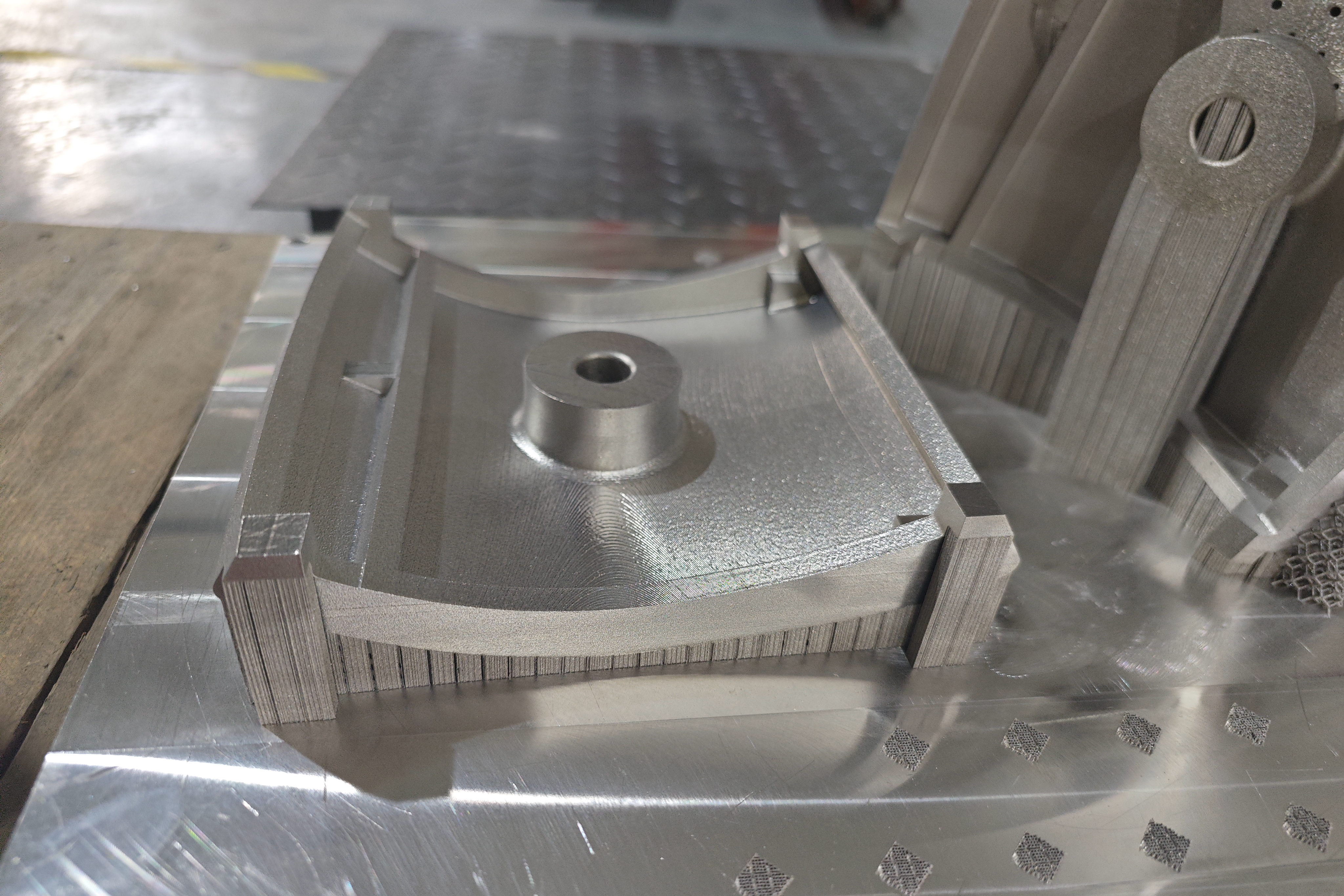Titanium Alloy Thermal Guards 3D Printed for Optimal Heat Resistance Performance
Introduction
Titanium alloys are renowned for their outstanding strength-to-weight ratio, excellent thermal stability, and corrosion resistance, making them an ideal choice for high-performance thermal protection systems. At Neway AeroTech, we specialize in 3D printing services for titanium alloys, manufacturing lightweight, complex thermal guards engineered for superior insulation and mechanical reliability in aerospace, industrial, and energy applications.
Using state-of-the-art Selective Laser Melting (SLM) technology, we produce precision-engineered titanium heat guards capable of operating under demanding thermal cycling and high mechanical loads.
Core Manufacturing Challenges for Titanium Thermal Guards
Producing titanium alloy thermal guards such as Ti-6Al-4V and Ti-6Al-2Sn-4Zr-6Mo by 3D printing presents critical challenges:
Managing high residual stresses and distortion during the rapid solidification of titanium due to its low thermal conductivity (~7.2 W/m·K).
Achieving near-full density (>99.5%) to ensure structural integrity and fatigue life.
Maintaining dimensional tolerances within ±0.05 mm, essential for assembly fit and aerodynamic performance.
Achieving surface finishes Ra ≤5 µm for thermal efficiency and oxidation resistance.
3D Printing Process for Titanium Alloy Thermal Guards
The advanced 3D printing process for titanium heat guards includes:
Powder Control: Using high-purity, spherical titanium alloy powders with particle sizes between 15–45 µm for consistent layer deposition.
Selective Laser Melting (SLM): Conducted in an inert argon atmosphere to prevent oxygen contamination and ensure high-density builds.
Process Parameter Optimization: Fine-tuning laser power (200–400 W), scan speed (600–800 mm/s), and layer thickness (30–50 µm) to minimize thermal gradients and porosity.
Support Removal and HIP Treatment: Removing build supports and performing Hot Isostatic Pressing (HIP) at ~920°C and 100 MPa to achieve >99.9% density.
Precision CNC Finishing: Final machining for critical surfaces achieving tolerances of ±0.01 mm and surface roughness Ra ≤1.6 µm.
Heat Treatment: Solution annealing and aging to optimize mechanical strength, creep resistance, and microstructural uniformity.
Comparison of Manufacturing Methods for Titanium Thermal Guards
Manufacturing Method | Dimensional Accuracy | Surface Finish (Ra) | Thermal Stability | Mechanical Strength | Cost Efficiency |
|---|---|---|---|---|---|
3D Printing (SLM) | ±0.05 mm | ≤5 µm | Excellent (up to 600°C) | Excellent | Medium |
Vacuum Investment Casting | ±0.1 mm | ≤3.2 µm | Good (up to 500°C) | Good | Medium |
CNC Machining (from Solid) | ±0.01 mm | ≤0.8 µm | Excellent (above 600°C) | Excellent | High |
Manufacturing Method Selection Strategy
Selection depends on design complexity, performance requirements, and economic considerations:
3D Printing (SLM): Optimal for lightweight, highly complex titanium shields with thin walls (≥1 mm) and integrated cooling features, enabling up to 30% weight reduction compared to conventional manufacturing.
Vacuum Investment Casting: Suitable for simpler shield geometries requiring moderate strength and good thermal protection.
CNC Machining (from Solid): Ideal for precision finishing or simple designs requiring ultra-tight dimensional control (±0.01 mm).
Titanium Alloy Performance Matrix
Alloy Material | Max Service Temp (°C) | Tensile Strength (MPa) | Density (g/cm³) | Fatigue Resistance | Typical Applications |
|---|---|---|---|---|---|
400 | 930 | 4.43 | Excellent | Compressor shields, aerospace thermal covers | |
550 | 1030 | 4.62 | Superior | High-temperature aerospace shielding | |
480 | 870 | 4.5 | Good | Industrial thermal barriers | |
540 | 965 | 4.6 | Excellent | Turbine shielding components | |
370 | 980 | 4.68 | Good | Lightweight thermal structures |
Alloy Selection Strategy for Thermal Guards
Correct alloy selection guarantees optimal thermal and mechanical protection:
Ti-6Al-4V: Chosen for turbocharger, aerospace, and industrial thermal shields needing high strength (930 MPa) and lightweight construction for temperatures up to 400°C.
Ti-6Al-2Sn-4Zr-6Mo: Ideal for high-temperature aerospace shields operating up to 550°C, offering excellent creep and fatigue resistance.
Ti-5Al-2.5Sn: Used for industrial heat barriers requiring moderate strength and good thermal stability around 480°C.
Ti-6Al-2Sn-4Zr-2Mo: Best for shielding applications in turbines needing sustained strength at 540°C.
Ti-15V-3Cr-3Sn-3Al: Selected for lightweight aerospace insulation components needing good mechanical strength and formability.
Key Post-processing Techniques
Critical post-processing steps for performance enhancement:
Hot Isostatic Pressing (HIP): Improves material density to >99.9% and enhances fatigue performance.
Heat Treatment: Solution treatment and aging to optimize strength, ductility, and creep resistance.
Precision CNC Finishing: Achieves dimensional tolerances (±0.01 mm) and surface finishes (Ra ≤0.8 µm) for critical surfaces.
Surface Protection Coatings: Application of oxidation and erosion-resistant coatings to extend service life in extreme environments.
Testing Methods and Quality Assurance
At Neway AeroTech, we conduct comprehensive aerospace-grade quality control:
Coordinate Measuring Machine (CMM): Dimensional validation within ±0.005 mm.
X-ray Inspection: Non-destructive internal defect detection.
Metallographic Microscopy: Microstructure evaluation for grain uniformity.
Tensile Testing: Mechanical strength and ductility confirmation.
All processes comply with AS9100 aerospace quality standards.
Case Study: 3D Printed Ti-6Al-2Sn-4Zr-6Mo Thermal Guards
Neway AeroTech manufactured Ti-6Al-2Sn-4Zr-6Mo thermal guards for aerospace turbine shielding:
Service Temperature: Continuous operation up to 550°C
Dimensional Precision: ±0.05 mm achieved across complex shield geometries
Surface Finish: Ra ≤4.5 µm after fine polishing
Certification: Fully compliant with AS9100 aerospace standards
FAQs
Why are titanium alloys ideal for high-temperature thermal guard applications?
What dimensional tolerances are achievable for 3D printed titanium thermal guards?
How does HIP processing enhance the performance of titanium 3D printed components?
Which titanium grades are best suited for thermal shields operating above 500°C?
What aerospace quality standards does Neway AeroTech follow for titanium guard manufacturing?

